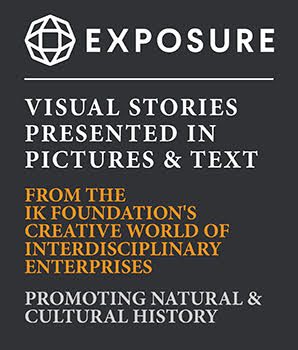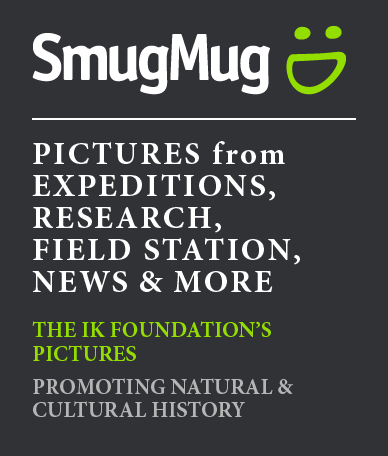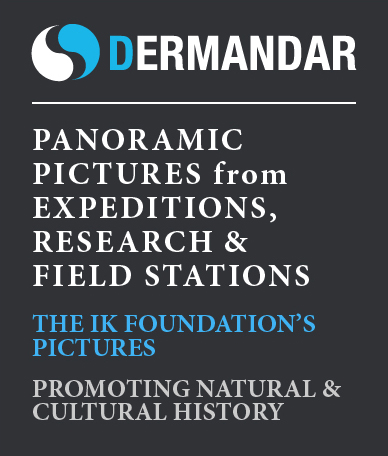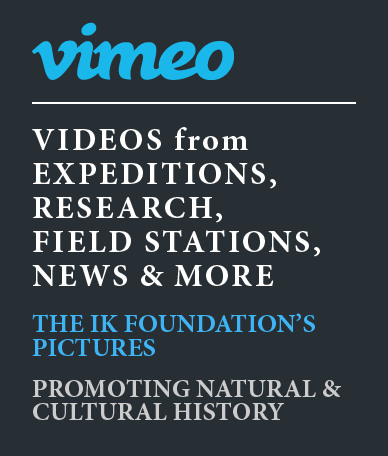ikfoundation.org
The IK Foundation
Promoting Natural & Cultural History
Since 1988





UPDATE (April 2020): SORRY! This project is delayed and will be dormant until the global pandemic has been brought under control.
UPDATE (4 March 2022): Due to Russia's attacks on Ukraine and the current political state in Kazakhstan, The IK Foundation has decided to refrain from actively developing current projects for the foreseeable future. This is regrettable from many points of view, but it is a fact! Our thoughts go to all our local fellow participants and people standing up for cross-border thoughts and knowledge.
Watch this space for updates!
UPDATE (4 March 2022): Due to Russia's attacks on Ukraine and the current political state in Kazakhstan, The IK Foundation has decided to refrain from actively developing current projects for the foreseeable future. This is regrettable from many points of view, but it is a fact! Our thoughts go to all our local fellow participants and people standing up for cross-border thoughts and knowledge.
Watch this space for updates!
BACKGROUND
The BRIDGE BUILDER EXPEDITIONS is the overarching definition for a series of contemporary and scientifically sustainable projects established by The IK Foundation, an undertaking which aims to inspire and to contribute to our understanding of our shared planet! These projects are grounded in the concepts of retracing and lifting both practical and theoretical knowledge from the Linnaeus Apostles' journeys. The core of said projects revolve around a series of expeditions – with fieldwork in both rural and urban landscapes – which will be used to collect data and knowledge from several of the world's continents. This work incorporates a look into both cultural and societal values of specific regions as well as the measuring of the natural permutations of the landscapes travelled three centuries ago and if they have shifted with the passing of time. In essence the BRIDGE BUILDER EXPEDITIONS are a mixture of 18th century knowledge and 21st century know-how, two contrasting entities employed in unison to create an endeavour which is both interdisciplinary but also groundbreaking within its field. These contemporary expeditions offer insight into the developments and constants of the world we live in, divergences which lay the groundwork for new avenues of knowledge.RUSSIA & KAZAKHSTAN
The second expedition within the project is the “BRIDGE BUILDER EXPEDITIONS – RUSSIA & KAZAKHSTAN” following in the footsteps of The Linnaeus Apostle Johan Peter Falck (1732-1774). In September 1763 Falck got a position as a learned keeper at the Kruse’s cabinet of natural history in St Petersburg. Here he called himself Ivan Petrovitj and he soon became a popular lecturer, regarded as greatly knowledgeable in natural history as well as medicine. Falck worked in St Petersburg during a five year period, before his long journey began in September 1768. Apart from the goal of reaching far eastwards in the immense country of Russia, the group of travellers explored the countryside by examining a great number of towns, villages, rivers, mountainous areas and steppes which they passed. The very coldest winter months being spent in one of the towns or larger villages along the route. In simple terms, Falck’s journey can be described as: from St Petersburg towards Moscow and Novgorod, then in a large southerly semi-circle across Tver, Ryazan, Penza, Saratow, Syzran, Tsaritzyn, Astrachan and back north to Moscow. Thereafter they went in a straight easterly direction towards Tambow, Ural, Orenburg, Barnaul and all the way to Tomsk in Siberia. In that the most easterly part of the journey, Omsk and its surrounding areas were circled before their return to Tomsk. Their journey then went westwards towards Kurgan, Samara and southwards to Astrachan, finally northwards to Saratow and on to Kazan, where Falck’s life ended tragically in suicide in Kazan, Russia, on 31 March 1774. More information on Falck as a person and his work can be found in iFACTS and iMAPS.Falck’s journal was published posthumously by J.G. Georgi in German 1785-86; Herr Joh. Pet. Falck: Beyträge zur Topographischen Kenntniss des Russischen Reichs… in three volumes. His comprehensive journal was first published in English 2007 – The Linnaeus Apostles - Global Science & Adventure (Volume Two) – by The IK Foundation & Company. The complete journal is also freely accessible as an iBOOK on this site. Falck’s way of amassing facts and with meticulous precision giving account for the most varied disciplines bore great similarities with Linnaeus’ methods of working. Life in the countryside and villages was reported from a number of perspectives; botany, zoology and mineralogy being central to his investigations. His journal gives important keys to the understanding of the vast Russian area in the 1760s and 1770s.
AIMS & IDEAS
In addition to the overarching goals which are initially described in conjunction with the BRIDGE BUILDER EXPEDITIONS, the work will seek out what is unique with each chosen Apostle’s work and to study (a selection of):- How said Apostles’ knowledge (practical/theoretical) was used after their initial observations in respective countries?
- If their observations have been used in modern contexts to understand change/happenings or in various analyses?
- To document a selection of physical locations visited by each respective Apostle and to try and find points of connection between then and now?
- Comprehensive looks at what benefits and/or influence – if not primarily historical – their journals and documentations have had for their respective nations and subjects?
The idea is to follow – in this case the journey of Johan Peter Falck – through observations but also interactions with people, organisations and institutions in seeking to gain a better understanding of how The Linnaeus Apostles’ work eventually became part of the practical and theoretical framework of knowledge through history. Work which built bridges between then, now and maybe even tomorrow.
PUBLIC DOMAIN & CROWD SCIENCE
The BRIDGE BUILDER EXPEDITIONS are presented in detail on their dedicated sites under iPROJECTS within iLINNAEUS. Here anyone interested can receive visual and textual updates from our members in the field, as well as results which said expeditions will create. The results themselves will be accessible via iLINNAEUS under the Creative Commons licences which we operate within, as well as in printed articles and publications.Interested individuals and organisations with local knowledge within the geographical and subject areas which the expeditions will encompass are welcome to get in touch with the IK Foundation. What is today denoted as Crowd Science was something the Linnaeus Apostles had great adherence to. We are especially interested in reaching out to projects which have used or use modern interpretations of the Apostles' work in their own studies and research!
iPROJECTS
iPROJECTS
In The IK Foundation and The IK Workshop Society there are continually ongoing comprehensive projects, each having different character and format. In iPROJECTS the current works and ideas are presented - Expeditions, Fieldwork, Research, Presentation in progress, and much more... For regular updates, and to make full use of iLINNAEUS' possibilities, we recommend fellowship by subscribing to our monthly newsletter iMESSENGER.
NAME OF PROJECT
- (Main title) The Linnaeus Apostles
BRIDGE BUILDER EXPEDITIONS
To Understand Planet Earth - (Subtitle) BRIDGE BUILDER EXPEDITIONS - RUSSIA & KAZAKHSTAN
GEOGRAPHICAL SCOPE
- The Russian Federation: (Российская Федерация)
- The Republic of Kazakhstan: (Қазақстан Республикасы)
SUBJECTS
- Geography
- 18th century Studies'
- Cultural History
- History of Science
- Natural History
- Economic History
TIMELINE
- 2013 Preparation and fund raising.
- 2014-2016 Fieldwork, research, documentation and follow-up work.
- 2016-2017: Fieldwork, fund raising and follow-up work.
- 2017-2019: Fund raising and follow-up work.
- 2020-2023: Fieldwork and follow-up work.
- 2024-2025: Publicise.
PUBLICISE
- iLINNAEUS.org
- Publications and articles
- Exhibitions
PATRONAGE
This site/project has been made globally available in collaboration with:
 The Thora Ohlsson Foundation, Lund, Sweden
The Thora Ohlsson Foundation, Lund, Sweden
Lars Gårdö, former President and CEO of Atle AB, Stockholm, Sweden
Frost River, Duluth, USA
Feel welcome to read more about how to take part...
LINKS | FURTHER READING




Updated/Checked 27/09/2023
THE IK FOUNDATION & COMPANY PROMOTING NATURAL & CULTURAL HISTORY
SUBSCRIBE TO OUR NEWSLETTER
TRANSLATE PAGE
A link to this page has
been copied to your clipboard
SHARE @been copied to your clipboard




© The IK Foundation & Company 2026
– a truly European organisation since 1988
– a truly European organisation since 1988
Legal issues | Forget me | and much more...
How to cite & Creative Commons
You are welcome to use the information and knowledge from
The IK Workshop Society, as long as you follow a few simple rules.
LEARN MORE & I AGREE
You are welcome to use the information and knowledge from
The IK Workshop Society, as long as you follow a few simple rules.
LEARN MORE & I AGREE











